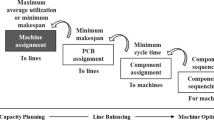Abstract
The hardware restrictions of surface mount placement machines, such as height, pick and place restrictions, and simultaneous pickup are often in printed circuit board (PCB)-related studies. This study proposes an efficient hybrid genetic algorithm (HGA) for solving the nozzle assignment problem and the component pick and place sequence problem. First, the proposed method obtains the sequence of the automatic nozzle changer (ANC) with the maximum number of simultaneous pickups and the minimum number of picks as the solution of the nozzle setup problem. Then, the proposed method uses the nearest neighbor search (NNS), 2-optimization, and a genetic algorithm (GA) with the known ANC sequences to obtain the PCB assembly time with the optimal component pick and place sequence. Experiments are conducted on the PCB of the EVEST EM-780 surface mount placement machine. Results show that the proposed HGA gives the lowest total number of picks, the shortest total head movement distance, and the minimum total PCB assembly time compared to those of other methods.

















Similar content being viewed by others
References
Flood MM (1956) The traveling salesman problem. Oper Res 4:61–75
Lee SH, Park TH, Lee BH, Kwon WH, Kwon W (1998) A dynamic programming approach to a reel assignment problem of a surface mounting machine in printed circuit board assembly. IEEE Int Conf Robot Autom 1:227–232
Wang W, Nelson PC, Tirpak TM (1999) Optimization of high-speed multistation SMT placement machines using evolutionary algorithms. IEEE Trans Electron Packag Manuf 22 (2):137– 146
Magyar G, Johnsson M, Nevalainen O (1999) On solving single machine optimization problems in electronics assembly. J Electron Manuf 9(4):249–267
Lee W, Lee S, Lee B, Lee Y (1999) An efficient planning algorithm for multi-head surface mounting machines using a genetic algorithm. J Univ Comput Sci 5(12):833–854
Burke E, Cowling P, Keuthen R (2001) The printed circuit board assembly problem: heuristic approaches for multi-headed placement machinery. In: Proceedings of the IC-AI2001. CSREA Press, Las Vegas
Ellis KP, Vittes FJ, Kobza JE (2001) Optimizing the performance of a surface mount placement machine. IEEE Trans Electron Packag Manuf 24(3):160–170
Jeevan K, Parthiban A, Seetharamu KN, Azid IA, Quadir GA (2002) Optimization of PCB component placement using genetic algorithms. J Electron Manuf 11(1):69–79
Ayob M, Kendall G (2003) A monte carlo hyper-heuristic to optimise component placement sequencing for multi head placement machine. In: Proceedings of the international conference on intelligent technologies, vol 3, pp 132–141
Ho W, Ji P (2003) Component scheduling for chip shooter machines: a hybrid genetic algorithm approach. Comput Oper Res 30(14):2175–2189
Kumar R, Luo Z (2003) Optimizing the operation sequence of a chip placement machine using tsp model. IEEE Trans Electron Packag Manuf 26(1):14–21
Ayob M, Kendall G (2004) A nozzle selection heuristic to optimize the hybrid pick and place machine. In: 2004 IEEE conference on cybernetics and intelligent systems, vol 2, pp 1260–1265
Oh AR, Park TH (2004) Assembly sequence optimization of dispensers in SMT in-line system. In: SICE 2004 annual conference, vol 1, pp 456–460
Ayob M, Kendall G (2008) A survey of surface mount device placement machine optimization machine classification. Eur J Oper Res 186(3):893–914
Lin WQ, Zhu GY (2008) A genetic optimization approach to optimize the multi-head surface mount placement machine. Lect Notes Comput Sci 5315:1003–1012
Jiang J, Chen X, Zang M, Wang Z, Tan Z (2010) Optimization of the surface mount technology based on the max-min ant system. IEEE Future Comput Commun (ICFCC) 2:45–47
Ashayeri J, Ma N, Sotirov R (2011) An aggregated optimization model for multi-head SMD placements. Comput Ind Eng 60(1):99–105
Zhang GH, Li ZB, Du X (2010) A hybrid genetic algorithm to optimize the printed circuit board assembly process. In: 2010 International conference on logistics systems and intelligent management, vol 1, pp 563–567
Loh TS, Bukkapatnam STS, Medeiros D, Kwon H (2001) A genetic algorithm for sequential part assignment for PCB assembly. Comput Ind Eng 40(4):293307
Sun DS, Lee TE, Kim KH (2005) Component allocation and feeder arrangement for a dual-gantry multi-head surface mounting placement tool. Int J Prod Econ 95(2):245264
Kanagaraj G, Ponnambalam SG, Lim WCE (2014) Application of a hybridized cuckoo search-genetic algorithm to path optimization for PCB holes drilling process. In: IEEE international conference on automation science and engineering (CASE), pp 373– 378
Chen T, Luo J, Hu Y (2011) Component placement process optimization for multi-head surface mounting machine based on tabu search and improved shuffled frog leaping algorithm. In: IEEE 3rd international workshop on intelligent systems and applications (ISA), pp 1–4
Zhang G, Li Z, Du X (2010) A hybrid genetic algorithm to optimize the printed circuit board assembly process. In: IEEE international conference on logistics systems and intelligent management, vol 1, pp 563–567
Author information
Authors and Affiliations
Corresponding author
Rights and permissions
About this article
Cite this article
Lin, HY., Lin, CJ. & Huang, ML. Optimization of printed circuit board component placement using an efficient hybrid genetic algorithm. Appl Intell 45, 622–637 (2016). https://doi.org/10.1007/s10489-016-0775-1
Published:
Issue Date:
DOI: https://doi.org/10.1007/s10489-016-0775-1



